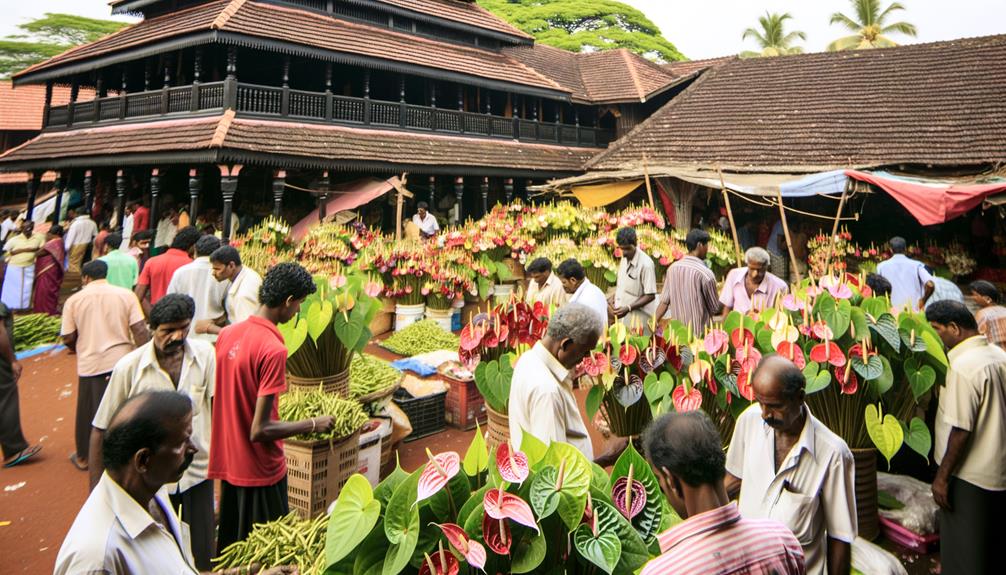7 Factors That Influence Anthurium Flower Prices in Kerala
To understand Anthurium flower prices in Kerala, look at seven key factors. Climatic conditions affect growth, with optimal temperature and humidity increasing yields.
Seasonal variations, especially during festive periods, drive demand shifts. High market demand during events boosts prices, while transportation costs heavily influence final costs due to fuel prices and distances.
Supply chain disruptions cause delays and price volatility. Pest and disease management is essential for quality and price stabilization.
Finally, labor costs play a significant role in production expenses. Each of these factors intricately shapes the market, and diving deeper will reveal their complex interactions.

Key Takeaways
- Climatic conditions affecting Anthurium growth influence yields and market prices.
- Seasonal variations cause demand fluctuations, impacting prices during peak and off-peak periods.
- Transportation costs contribute significantly to final Anthurium prices due to distance and fuel expenses.
- Supply chain disruptions can cause delays and increase operational costs, affecting prices.
- Market demand driven by festivals and consumer behavior significantly influences Anthurium prices.
Climatic Conditions
Climatic conditions greatly influence the growth and quality of Anthurium flowers in Kerala, directly impacting their market prices. You'll find that ideal temperatures for Anthurium range between 20°C and 30°C, with humidity levels around 80%.
Deviations from these conditions can decrease flower size and color vibrancy, leading to lower market prices. For example, data shows that during periods of higher-than-average temperatures, Anthurium yields can decrease by up to 15%.
Additionally, consistent rainfall is essential; too much or too little water can cause root diseases or stunted growth. Monitoring these climatic factors helps predict market fluctuations, giving growers and sellers a strategic advantage.
Therefore, understanding the precise climatic needs of Anthuriums guarantees you can maximize both quality and profit.
Seasonal Variations
You should consider how seasonal variations affect both supply and demand for Anthurium flowers in Kerala. During peak seasons, high demand often coincides with ideal climate conditions, driving prices up.
Conversely, off-peak seasons may see reduced demand and less favorable growing conditions, leading to lower prices.
Supply and Demand
Seasonal variations profoundly affect the supply and demand dynamics of Anthurium flowers in Kerala, with data indicating peak demand during festive periods. During Onam and Christmas, demand surges by 30-40%, driven by cultural and decorative needs. However, supply often lags due to farmers' limited storage capacities and cultivation cycles. This imbalance hikes prices significantly.
Conversely, off-peak seasons see a 20-25% decline in demand, leading to surplus stock and reduced prices. Farmers struggle with oversupply, as cultivation can't be adjusted swiftly. Data shows that during these times, prices drop by 15-20%.
Understanding these patterns helps you predict market changes and manage inventory efficiently, ensuring you maximize profitability while minimizing waste.
Climate Conditions
While supply and demand play an important role in impacting Anthurium flower prices, variations in Kerala's climate also play a key role in shaping market dynamics.
You'll find that seasonal changes greatly affect Anthurium cultivation. During the monsoon season, high humidity and consistent rainfall create ideal growing conditions, boosting flower production and potentially lowering prices. Conversely, the dry season can stress plants, reducing yield and driving prices up.
Temperature fluctuations also matter; ideal growth occurs between 20-30°C. Deviations from this range can hinder flower quality and quantity.
You must consider these climatic variables when analyzing price trends, as they directly influence supply availability and market stability. Understanding these factors helps you make informed decisions in the flower market.
Market Demand
You should examine how seasonal purchase trends affect anthurium prices, as fluctuations in demand can greatly impact costs. Analyzing consumer buying patterns will reveal how preferences and spending habits shift over time.
Additionally, consider how regional popularity shifts influence market demand, potentially causing price variations across different areas in Kerala.
Seasonal Purchase Trends
Market demand for Anthurium flowers in Kerala fluctuates noticeably throughout the year, driven by seasonal festivals, weddings, and other cultural events.
During the Onam festival, for instance, demand spikes as flowers are integral to the traditional Pookalam designs. Similarly, the wedding season, typically from November to February, sees a marked increase in Anthurium purchases.
Data shows a 30% rise in sales during these peak periods compared to off-season months. Conversely, demand dips during monsoon months when fewer events are held.
Understanding these trends can help you predict market behavior and make informed decisions about inventory and pricing. By aligning your supply with these seasonal demands, you can optimize profitability and reduce surplus stock.
Consumer Buying Patterns
In addition to seasonal trends, consumer buying patterns for Anthurium flowers in Kerala are influenced by factors such as income levels, cultural preferences, and marketing strategies.
First, income levels play a significant role; higher disposable income increases the likelihood of purchasing ornamental flowers.
Second, cultural preferences affect demand; for example, specific festivals and ceremonies often see a spike in flower purchases.
Third, marketing strategies impact consumer behavior; effective promotions and advertising can drive up sales.
Analyzing these elements helps understand market demand fluctuations. By focusing on these factors, you can better predict pricing trends and adjust your business strategies accordingly.
A data-driven approach allows you to cater to consumer needs more precisely and optimize your pricing model.
Regional Popularity Shifts
Analyzing regional popularity shifts reveals that varying local tastes and preferences directly impact market demand for Anthurium flowers in Kerala. You'll notice that districts like Thiruvananthapuram and Ernakulam show a higher preference for Anthuriums due to their use in upscale events and home decor.
In contrast, rural areas may favor traditional flowers over exotic ones, reducing Anthurium demand there. Data indicates that urbanization rates and income levels correlate with these preferences. As a result, florists in urban centers stock more Anthuriums, driving prices up. Conversely, in regions with low demand, prices tend to drop.
Monitoring these shifts helps you understand how localized consumer behavior influences the overall market dynamics for Anthurium flowers in Kerala.
Transportation Costs
Transportation costs play a significant role in determining the final price of Anthurium flowers in Kerala.
You'll notice that these expenses can vary widely based on several factors:
- Distance: The farther the flowers need to travel, the higher the cost. Transportation from remote regions can be particularly expensive.
- Mode of Transport: Air freight is faster but costlier compared to road or rail. However, it's often necessary for maintaining the flowers' freshness.
- Fuel Prices: Rising fuel prices directly impact transportation costs, which in turn affect the overall flower prices.
Supply Chain Issues
Supply chain disruptions heavily impact Anthurium flower prices in Kerala by causing delays and increasing operational costs. When supply chains break down, you face delayed shipments, spoilage, and higher storage fees. This forces suppliers to raise prices to cover additional expenses. A delayed shipment means flowers might not arrive fresh, leading to a loss of quality and market value. Additionally, increased fuel prices and logistical challenges compound the issue, making it harder for you to secure a steady supply at reasonable costs.
Here's a snapshot of the impact:
| Factor | Consequence | Resulting Effect on Prices |
|---|---|---|
| Delayed Shipments | Flower spoilage | Increased prices |
| Higher Storage Fees | Operational cost increases | Price hikes |
| Logistical Challenges | Inconsistent supply | Price volatility |
Understanding these issues can help you better navigate the complexities of the Anthurium market.
Pest and Disease Control
Effective pest and disease control is essential for maintaining the quality and market value of Anthurium flowers in Kerala. You need to adopt strategic measures to safeguard your crops. Data shows that effective management can reduce yield loss by up to 30%.
Here's a concise approach to contemplate:
- Regular Monitoring: Implement routine checks for early detection of pests like thrips and diseases such as bacterial blight, which can devastate crops.
- Integrated Pest Management (IPM): Utilize a combination of biological controls, chemical treatments, and cultural practices to minimize pest impact.
- Sanitation Practices: Maintain clean growing environments by removing plant debris and disinfecting tools to prevent disease spread.
These steps will ensure healthier plants and more consistent flower quality, directly influencing market prices.
Labor Costs
Labor costs have a significant impact on the profitability of Anthurium flower cultivation in Kerala, with wages accounting for approximately 40% of total production expenses.
You need to understand that labor-intensive activities such as planting, pruning, and harvesting require skilled workers, which drives up costs.
Additionally, seasonal fluctuations in labor availability can further affect wage levels, potentially creating inconsistencies in your budget.
To mitigate these costs, you might consider implementing mechanization where feasible or optimizing labor allocation through better planning and training.
By efficiently managing labor resources, you can potentially lower production costs, thereby improving your profit margins.
Keeping an eye on labor market trends and adjusting your practices accordingly will be vital for maintaining competitiveness in the Anthurium market.
Conclusion
In the ever-changing market of anthurium flowers in Kerala, your wallet's health hinges on a blend of climatic conditions, seasonal shifts, and market demand.
When transportation costs, supply chain hiccups, pest control, and labor expenses play their part, prices can fluctuate like a seesaw.
By staying informed and analyzing these seven factors, you can navigate the floral market with precision, ensuring you get the best value for your blooms.






